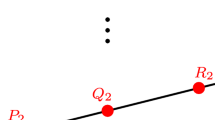Abstract
Motivated by a problem in computer architecture we introduce a notion of the perfect distance-dominating set (PDDS) in a graph. PDDSs constitute a generalization of perfect Lee codes, diameter perfect codes, as well as other codes and dominating sets. In this paper we initiate a systematic study of PDDSs. PDDSs related to the application will be constructed and the non-existence of some PDDSs will be shown. In addition, an extension of the long-standing Golomb–Welch conjecture, in terms of PDDS, will be stated. We note that all constructed PDDSs are lattice-like which is a very important feature from the practical point of view as in this case decoding algorithms tend to be much simpler.
Similar content being viewed by others
References
Ahlswede R., Blinovsky V.: Lectures on Advances in Combinatorics. Springer, Berlin (2008)
Ahlswede R., Audinian H.K., Khachatrian L.H.: On perfect codes and related concepts. Des. Codes Cryptogr. 22, 221–237 (2001)
AlBdaiwi B.F., Bose B.: Quasi-perfect Lee distance codes. IEEE Trans. Inf. Theory 49, 1535–1539 (2003)
AlBdaiwi B.F., Livingston M.L.: Perfect distance d-placements in 2d-toroidal networks. J. Supercomput. 29, 45–57 (2004)
Araujo C., Dejter I.J.: On perfectly dominating \({\mathbb{Z}^{3}}\) with squares (submitted).
Bange D.W., Barkauskas A.E., Slater P.J.: Efficient dominating sets in graphs. In: Ringeisen R.D., Roberts F.S. (eds.) Applications in Discrete Mathematics, pp. 189–199. SIAM, Philadelphia (1988).
Biggs N.: Algebraic Graph Theory. Cambridge University Press, Cambridge (1993)
Buzaglo S., Etzion T.: Tilings by (0.5, n)-Crosses and Perfect Codes. online: arXiv:1107.5706v1.
Costa S.I., Muniz M., Agustini E., Palazzo R.: Graphs, tessellations, and perfect codes on flat tori. IEEE Trans. Inf. Theory 50, 2363–2377 (2004)
Dejter I.J.: Perfect domination in regular grid graphs. Australas. J. Comb. 42, 99–114 (2008)
Dejter I.J., Delgado A.A.: Perfect domination in rectangular grid graphs. J. Comb. Math. Comb. Comput. 70, 177–196 (2009)
Dejter I.J., Phelps K.T.: Ternary Hamming and binary perfect covering codes. In: Barg A., Litsyn S. (eds.) Codes and Association Schemes. DIMACS Series Discrete Mathematics and Theoretical Computer Science, vol. 56, pp. 111–113. American Mathematical Society, Providence (2001).
Dejter I.J., Serra O.: Efficient dominating sets in Cayley graphs. Discret. Appl. Math. 119, 319–328 (2003)
Dejter I.J., Weichsel P.M.: Twisted perfect dominating subgraphs of hypercubes. Congr. Numerantium 94, 67–78 (1993)
Etzion T.: Product constructions for perfect Lee codes. IEEE Trans. Inf. Theory (to appear).
Fellows M.R., Hoover M.N.: Perfect domination. Australas. J. Comb. 3, 141–150 (1991)
Golomb S., Welch K.: Perfect codes in the Lee metric and the packing of polyominos. SIAM J. Appl. Math. 18, 302–317 (1970)
Hickerson D., Stein S.: Abelian groups and packings by semicrosses. Pac. J. Math. 122, 96–109 (1986)
Horak P., AlBdaiwi B.F.: Non-periodic tilings of R n by crosses. Discret. Comput. Geom. 47, 1–16 (2012)
Horak P., AlBdaiwi B.F.: Diameter perfect Lee codes. IEEE Trans. Inf. Theory. Online: arXiv:1109.3475 (to appear).
Klostermeyer W.F., Goldwasser J.L.: Total perfect codes in grid codes. Bull. Inst. Comb. Appl. 46, 61–68 (2006)
Kratochvil J., Krivánek M.: On the computational complexity of codes in graphs. In: Proceedings of the MFCS 1988. Lecture Notes in Computer Science, vol. 324, pp. 396–404, Springer, Berlin.
Minkowksi H.: Dichteste gitterformige Lagerung kongruenter Korper. Nachrichten Ges. Wiss. Gottingen, pp. 311–355 (1904).
Molnár E.: Sui Mosaici dello spazio de dimensione n. Atti della Accademia Nazionale dei Lincei. Rend. Sc. Fis. Mat. e Nat. 51, 177–185 (1971)
Schwartz M.: Quasi-cross lattice tilings with applications to flash memory (submitted).
Stein S.: Factoring by subsets. Pac. J. Math. 22, 523–541 (1967)
Stein S.: Packings of R n by certain error spheres. IEEE Trans. Inf. Theory 30, 356–363 (1984)
Szabó S.: On mosaics consisting of multidimensional crosses. Acta Math. Acad. Sci. Hung. 38, 191–203 (1981)
Weichsel P.M.: Dominating sets of n-cubes. J. Graph Theory 18, 479–488 (1994)
Author information
Authors and Affiliations
Corresponding author
Additional information
This paper is dedicated to the memory of Lucia Gionfriddo.
This is one of several papers published in Designs, Codes and Cryptography comprising the “Special Issue on Coding Theory and Applications”.
Rights and permissions
About this article
Cite this article
Araujo, C., Dejter, I. & Horak, P. A generalization of Lee codes. Des. Codes Cryptogr. 70, 77–90 (2014). https://doi.org/10.1007/s10623-012-9666-6
Received:
Revised:
Accepted:
Published:
Issue Date:
DOI: https://doi.org/10.1007/s10623-012-9666-6




